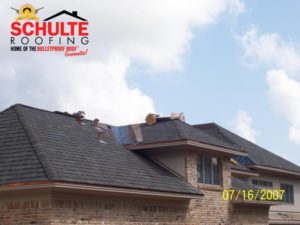The most common enemy of all The Woodlands roofing is the material’s susceptibility to various elements of nature. Whether that cause is sun’s heat, rain , strong wind, hail, or snow, the impact is extremely large, especially on its level of performance. Another problem that is given great importance nowadays by roofing companies is the level of humidity in certain regions. It is assumed that the presence of moisture will hasten the decay of wood supporting structures, fast-track the metal corrosion of fasteners and decks, be a cause of clay staining, and frost-thaw weathering.
, strong wind, hail, or snow, the impact is extremely large, especially on its level of performance. Another problem that is given great importance nowadays by roofing companies is the level of humidity in certain regions. It is assumed that the presence of moisture will hasten the decay of wood supporting structures, fast-track the metal corrosion of fasteners and decks, be a cause of clay staining, and frost-thaw weathering.
Impact of Increased Humidity Level
Humidity is directly linked to condensation. For industrial roofing systems, the roofing structure is potentially susceptible to condensation problems which will lead to expensive moisture damage in the building. During clear nights, the cooling effect of the night causes the roof temperature to decrease below the ambient air temperature. This sudden reduction of roof temperature increases water vapor in the air. Water vapor is readily absorbed by building structures specifically wood. The absorption of moisture causes wooden structures to swell, however when moisture evaporates during the daytime, the structure shrinks and creates more trouble.
Controlling High Indoor Humidity Levels
Humidity is defined as the amount of water vapor in the air. Controlling humidity levels is of paramount importance not only for physiologic reasons but also for structural purposes. There are several devices to control (humidistat) and regulate (dehumidifier) indoor humidity. The device used to measure humidity is called a hygrometer.
The first thing to do to solve a humidity problem is to verify and measure its level using an hygrometer. When the measurement is high, The Woodlands roofing companies suggest installing a humidistat and a dehumidifier. Ventilation and air-conditioning units also help in controlling humidity levels. The key factor in controlling the indoor humidity level is to monitor relative humidity and dehumidification.
Moisture Exposure of Low-Slope Roofing
Moisture exposure of low-slope roofing is an expensive roofing problem in the United States. Thermal loss is a multi-billion dollar expense created by inadequate roofing insulation causing moisture exposure. In fact, the most common reason for re-roofing done in the United States is moisture.
As a result, the roofing industry developed moisture-resistant and energy-saving roofing systems. Moisture can penetrate the roofing system in two ways. The number one reason is membrane or edge detailing failures, and the second is exposure to different weather conditions.
Roofing Houston companies install waterproof membrane to low-slope roofs to prevent water penetration. Controlling moisture and indoor humidity is important to achieve a healthy and safe working environment. Increased humidity levels can bring structural deterioration in the course of time. The majority of homeowners run air-conditioning units to regulate and control humidity levels; however, this method seems to be very expensive because of the increased energy consumption. Some homeowners have opted to install dehumidifiers to control humidity levels and others install moisture-resistant membranes on the roofing system to regulate humidity.
Humidity is a common problem that is not unique to roofing structures. A high humidity level is not good for people using the building because it has a negative impact on health. The Environmental Protection Agency (EPA) stated that the indoor humidity level should be within the range of 35 percent to 50 percent.
